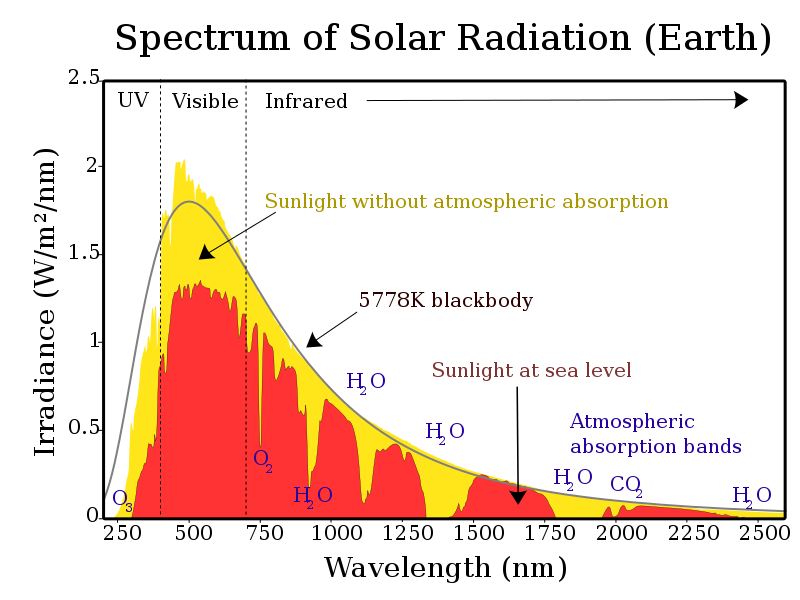Fail:Solar spectrum en.svg

Size of this PNG preview of this SVG file: 800 × 600 piksel. Leraian-leraian lain: 320 × 240 piksel | 640 × 480 piksel | 1,024 × 768 piksel | 1,280 × 960 piksel | 2,560 × 1,920 piksel.
Fail asli (Fail SVG, ukuran dasar 800 × 600 piksel, saiz fail: 49 KB)
Sejarah fail
Klik pada tarikh/waktu untuk melihat rupa fail tersebut pada waktu itu.
| Tarikh/Waktu | Gambar kenit | Ukuran | Pengguna | Komen | |
|---|---|---|---|---|---|
| semasa | 16:10, 13 Mei 2019 |  | 800 × 600 (49 KB) | Tuvalkin | It's W, not kW, as further discussed: Reverted to version as of 20:57, 21 February 2016 (UTC) |
| 14:13, 25 Februari 2019 |  | 800 × 600 (49 KB) | Tuvalkin | W → kW, as dicussed | |
| 20:57, 21 Februari 2016 |  | 800 × 600 (49 KB) | BenRG | Replace 5250°C blackbody (seemingly miscalculated anyway) with standard 5778K blackbody; center-align captions; use Unicode ² instead of SVG superscript to fix rendering problems | |
| 22:21, 7 Januari 2015 |  | 800 × 600 (50 KB) | Bendhoward | The Y-axis units were changed at some point to W/m^2, which is not correct. The units have been changed back to W/m^2/nm, in accordance with the units of the X-axis. | |
| 22:25, 4 September 2014 |  | 800 × 600 (50 KB) | TxBangert | ... changed ^2 to superscript | |
| 22:18, 4 September 2014 |  | 800 × 600 (50 KB) | TxBangert | fixed minor errors in how Wikipedia renders svg image | |
| 10:28, 4 September 2014 |  | 800 × 600 (50 KB) | TxBangert | Updated the text to bring it in more in line with other European versions of this graph. W/m2/nm on the y axis is wrong. The units are simply W/m2, the x axis is nm. | |
| 14:50, 4 Mac 2013 |  | 800 × 600 (50 KB) | Arbeck | Typo corrected - Atmosphere | |
| 15:44, 14 Februari 2013 |  | 800 × 600 (50 KB) | Arbeck | Typo corrected: visible | |
| 15:44, 14 Februari 2013 |  | 800 × 600 (50 KB) | Arbeck | Typo correctedvisible |
Penggunaan fail
Laman berikut menggunakan fail ini:
Penggunaan fail sejagat
Fail ini digunakan oleh wiki-wiki lain yang berikut:
- Penggunaan di ca.wikipedia.org
- Penggunaan di de.wikipedia.org
- Penggunaan di el.wikipedia.org
- Penggunaan di en.wikipedia.org
- Penggunaan di es.wikipedia.org
- Penggunaan di eu.wikipedia.org
- Penggunaan di hak.wikipedia.org
- Penggunaan di hi.wikipedia.org
- Penggunaan di hu.wikipedia.org
- Penggunaan di ig.wikipedia.org
- Penggunaan di ja.wikipedia.org
- Penggunaan di sk.wikipedia.org
- Penggunaan di te.wikipedia.org
- Penggunaan di uz.wikipedia.org
- Penggunaan di vi.wikipedia.org










